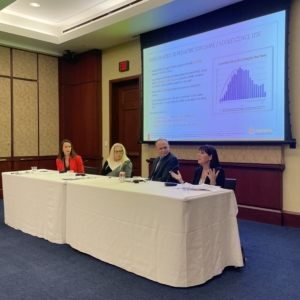 By Nancy Glick, Director of Food and Nutrition Policy
By Nancy Glick, Director of Food and Nutrition Policy
For historians, 2003 will be remembered as the year that the space shuttle Columbia crashed, scientists finished sequencing the human genome, and the U.S. launched war against Iraq.
But 2003 also marks an important milestone for American consumers. In December of that year, three national consumer organizations – the National Consumers League (NCL), Center for Science in the Public Interest (CSPI), and the Consumer Federation of America (CFA) – first petitioned the federal government to require an easy to read, standardized “Alcohol Facts” label on all beer, wine and distilled spirits products. This sparked a 19-year battle that is finally paying off for the estimated 67 percent of Americans[1] who drink alcoholic beverages.
In 2003, the Nutrition Facts label on processed foods and non-alcoholic beverages had been in use for almost a decade (1994) and many consumers said they frequently or almost always read the label. Thus, public acceptance and use of the Nutrition Facts label created built-in public support for an Alcohol Facts label. In fact, polling NCL commissioned in both 2005 and 2007 showed overwhelming public support for comprehensive alcohol labeling. Now, polling consistently shows that 75 percent of Americans think alcoholic beverages should have standardized alcohol content labels and 72 percent say this labeling will encourage responsible alcohol use.
Even more significantly, not knowing what is in a beer, wine or distilled spirits drink increases the risk for overconsumption of alcohol, a serious and costly public health problem. According to the latest research findings, alcohol is a source of empty calories that contribute to obesity,[2] and can impact blood sugar control in people with diabetes.[3] Additionally, alcohol is a roadway killer accounting for about 30 percent of all traffic crash fatalities in the U.S.,[4] and excessive drinking increases the risk of liver disease, hypertension, cardiovascular disease, alcohol use disorders, certain cancers and severe injuries.[5] Consequently, an estimated 140,000 people in the United States die annually from alcohol- related causes,[6] which is why the cost of excessive alcohol use reached $249 billion in 2010 and is likely higher today..[7]
Based on this documented evidence, the 2003 petition, which was also signed by 73 nutrition/public health organizations and experts, called for a label that gives consumers the needed information to make responsible drinking decisions, such as the serving size, amount of alcohol and calories per serving, the percent alcohol by volume, and the number of standard drinks per container. And yet, the lead federal agency that regulates alcoholic beverages – the Alcohol and Tobacco Tax and Trade Bureau (TTB) – deliberated but failed to take meaningful action for almost two decades.
The arcane process started in 2005 with an advance notice of proposed rulemaking, which produced over 19,000 public comments. In 2006, TTB issued another notice of proposed rulemaking on allergen labeling followed by a notice in 2007 on alcohol and nutrition labeling. Unfortunately, however, TTB allowed these proposed rules to languish, ultimately deciding in 2013 to issue a voluntary rule allowing companies to decide what nutrition and calorie information to disclose – and what to keep hidden. Not surprisingly, many manufacturers opted out of TTB’s program so most alcoholic beverage products on the market remain unlabeled or carry incomplete information.
Even with these setbacks, the consumer community kept up the pressure on TTB because the need for alcohol labeling has only increased. This became apparent during the COVID-19 pandemic when a 2020 RAND study charted a 14 percent increase in alcohol consumption among adults over age 30 in one year.[8] Another national study found that excessive (binge) drinking increased by 21 percent during the pandemic, with the potential for 8,000 additional deaths from alcohol-related liver disease by 2040.[9]
And then, the sand started to shift. Also related to the pandemic, consumer demand skyrocketed for hard ciders, some types of beers, wine coolers and the other low-alcohol drinks sold in supermarkets and convenience stores and what consumers saw were complete alcohol labels on these products. This is because low-alcohol drinks fall under the purview of the Food and Drug Administration, not TTB. Armed with this evidence, NCL leaders met online with Department of Treasury and TTB officials in June 2021 and put TTB in the uncomfortable position of having to explain why often the same manufacturers who must put a standardized content label on brands regulated by FDA don’t bother to do so when their products are under TTB’s jurisdiction.
Not long after this meeting, the Treasury Department conducted its own review and on February 9, 2022, issued a report, Competition in the Markets for Beer, Wine and Spirits, that advanced the importance of labeling information to foster competition within the beverage alcohol industry. The report contains several recommendations, including the recommendation that “TTB should revive or initiate rulemaking proposing ingredient labeling and mandatory information on alcohol content, nutritional content, and appropriate serving sizes.”
This was encouraging news, so NCL doubled down, combining forces with CSPI and the Consumer Federation of America to get TTB to mandate alcohol labeling across the board. Recognizing that public pressure alone will not ensure success, the organizations turned to Congress, hosting briefings for lead staffers of the House and Senate appropriations committees with jurisdiction over TTB’s budget and sending a joint letter to key Congressional leaders from 23 consumer, health/nutrition, and alcohol policy organizations about the need for mandatory alcohol labeling. This led to report language in the draft House and Senate 2023 appropriations bills that encourages TTB to initiate a final rulemaking.
The last step was filing a lawsuit against TTB in the United States District Court for the District of Columbia on October 3, 2022, asking the court to direct TTB to grant or deny the 2003 petition within 60 days. The lawsuit was a gamble, but it worked: on November 17, 2022, TTB accepted the 2003 petition and committed to publish three rulemakings covering mandatory nutrient and alcohol content labeling, mandatory allergen labeling, and mandatory ingredient labeling within the next year.
However, this is not the end of the story. The proposed rules will be accompanied by open public comment periods where we can anticipate that segments of the alcohol industry will be aggressive in fighting robust consumer labeling. Therefore, NCL will also be actively engaging a wide range of stakeholders to weigh in on behalf of consumers so the American public to have access to standardized and complete labeling information on beer, wine and distilled spirits. It has taken 19 years to get to this point, but our message is clear: alcohol labeling is long past due, consumers overwhelmingly want to see it, and we will stay in the fight until alcohol labeling is a reality.
[1] Gallup. Alcohol & Drinking. July 2022
[2] U.S. Department of Agriculture and U.S Department of Health and Human Services. Dietary Guidelines for Americans, 2020-2025. 9Th Edition. December 2020.
[3] Emanuele NV, et al. Consequences of Alcohol Use in Diabetics. Alcohol Health Res World. 1998; 22(3): 211–219.
[4] National Highway Traffic Safety Administration. Risky Drunk and Drugged Driving Statistics.
[5] U.S. Centers for Disease Control and Prevention. Alcohol and Public Health. Last reviewed April 14, 2022. https://www.cdc.gov/alcohol/fact-sheets/alcohol-use.htm
[6] U.S. Centers for Disease and Control Prevention. Deaths from Excessive Alcohol Use in the U.S. Page last reviewed April 14, 2021. https://www.cdc.gov/alcohol/features/excessive-alcohol-deaths.html . Accessed June 2, 2022.
[7] U.S. Centers for Disease Control and Prevention. Alcohol and Public Health. Page last reviewed April 14, 2022. https://www.cdc.gov/alcohol/features/excessive-drinking.html. Accessed June 2, 2022.
[8] Pollard MS, et al. Changes in Adult Alcohol Use and Consequences During the COVID-19 Pandemic in the US. JAMA Netw Open. 2020;3(9):e2022942.
[9] Julien J, et al. Effect of increased alcohol consumption during COVID-19 pandemic on alcohol-associated lover disease: A modeling study. Hepatology. Vol. 75; Issue 6; June 2022; 1480-1490.



 By Nancy Glick, Director of Food and Nutrition Policy
By Nancy Glick, Director of Food and Nutrition Policy
 Cannabis Consumer Watch recently hosted a briefing on Capitol Hill to educate policymakers and staff on the public health risks that exist in the current cannabis marketplace, and to offer policy solutions that would help protect consumer safety and encourage innovation for patients. The briefing was moderated by the Collaborative for Cannabinoid Science and Safety’s Libby Baney, and the panel of experts included:
Cannabis Consumer Watch recently hosted a briefing on Capitol Hill to educate policymakers and staff on the public health risks that exist in the current cannabis marketplace, and to offer policy solutions that would help protect consumer safety and encourage innovation for patients. The briefing was moderated by the Collaborative for Cannabinoid Science and Safety’s Libby Baney, and the panel of experts included:
 By Health Policy Intern Grace Lassila
By Health Policy Intern Grace Lassila













